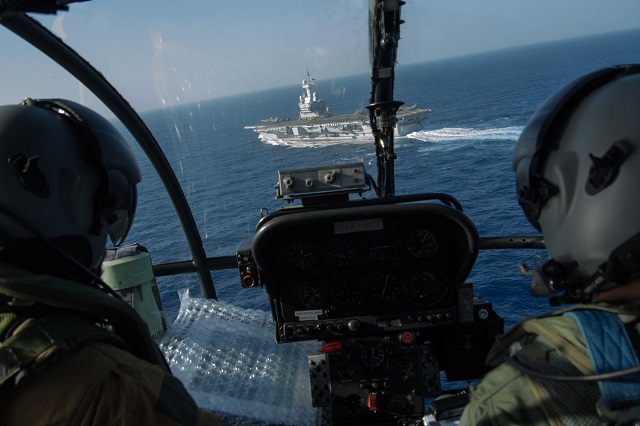By Petty Officer 3rd Class Janweb Lagazo, USS Mason (DDG 87) Public Affairs
Leadership from the guided-missile destroyer USS Mason (DDG 87) and French officials from the Charles de Gaulle Strike Group (CDGSG) met while operating together in the Eastern Mediterranean Sea, Nov. 25, 2016. Cmdr. Christopher J. Gilbertson of Minneapolis, Mason’s commanding officer, met Rear Adm. Olivier Lebas, commander of the CDGSG, and other French officials to solidify strategies and tactics in support of Operation Inherent Resolve (OIR).
|

MEDITERRANEAN SEA (Nov. 25, 2016) Pilots prepare to land on the French aircraft carrier FS Charles de Gaulle (R91) while transporting the commanding officer of the guided-missile destroyer USS Mason (DDG 87) for a scheduled visit. Mason, deployed as part of the Eisenhower Carrier Strike Group. U.S. 6th Fleet, headquartered in Naples, Italy, conducts the full spectrum of joint and naval operations, often in concert with allied, joint, and interagency partners, in order to advance U.S. national interests and security and stability in Europe and Africa.. (U.S. Navy photo by Petty Officer 3rd Class Janweb B. Lagazo/Released) |
|
“It is a privilege and a wonderful opportunity to provide support to CDGSG and OIR,”Gilbertson said. “We have worked with many of our multi-national partners over the past six months, and the crew has performed admirably every time. We enjoyed a very successful joint operation with the destroyer FS Forbin (D620) earlier this deployment and look forward to working with our friends and partners again.”
Mason is deployed to support maritime security operations and theater security cooperation efforts in the U.S. 6th Fleet area of operations. Mason replaced the guided-missile destroyer USS Ross (DDG 71), which provided multi-warfare defense support to CDGSG from Sep. – Oct. 2016. The ship’s operations are an example of the commitment the U.S. and its NATO allies have to maintaining a safe, secure and prosperous Europe and Middle East.
CDGSG operations from the Mediterranean Sea work in tandem with OIR efforts in the U.S. 5th Fleet area of operations by supporting the fight against the Daesh or Islamic State of Iraq and the Levant (ISIL) while demonstrating a carrier strike group’s ability to perform integrated multi-national air strikes.
“The mission of the [CDGSG] is to reinforce and strengthen the French’s involvement against Daesh in Iraq and Syria,” Lebas said. “We are here to participate as a coalition, and while doing so, help build a strong picture of the freedom of maneuvering in this area.”
Lebas went on to comment that the freedom to maneuver is especially important for an aircraft carrier as it allows for the “maximum amount” of safety for all ships in the area. He believes that securing the maritime environment in this region of the Mediterranean Sea can promote “regional and global economic security.”
“No nation is able to fight Daesh alone,” Lebas said. “It is a worldwide problem and we need to be together.”
French and U.S. naval forces, along with other NATO allies, continue to forge a global network of navies by collectively working together to share information, experiences and resources in an effort to foster regional security.
“We coordinate with the actions of the Eisenhower Carrier Strike Group (Ike CSG) to optimize our scheduling to offer the best support for the coalition,” Lebas remarked. “We use this time together to develop our relationship. It’s good to have Mason to fuel this relationship for the two navies.”
Lebas mentioned the CDGSG as an important factor in supporting Iraqi and Kurdish security forces involved in the battle for Mosul, in Northern Iraq, while engaging in a strong, concerted push towards Raqqa, the Islamic State’s self-proclaimed capital in Syria.
“We can bring significant additional force to be able to conduct the battles in both theatres, mostly in Mosul but also in Raqqa,” said Lebas. “We have the sufficient amount of aircraft to support actions in both theatres.”
Mason hopes to demonstrate the United States’ commitment to the French by providing multi-mission capabilities in key warfare areas, especially missile defense and anti-submarine warfare. As one of the U.S. Navy’s two “Bloodhound Award” winners for the best anti-submarine warfare ship for 2015, Mason is a proven expert.
“It’s very important for me to have the opportunity to integrate Mason because it is strong and full of capabilities,” Lebas said. “That is also a sign of the strong relationship between the French and U.S. navies because we have a common enemy and common objective in maintaining freedom of navigation in the Mediterranean Sea, Arabian Sea, Persian Gulf, Indian Ocean and the Atlantic. We have relied on each other for many years. We have a strong and vital history together through the difficult and challenging times.”
|